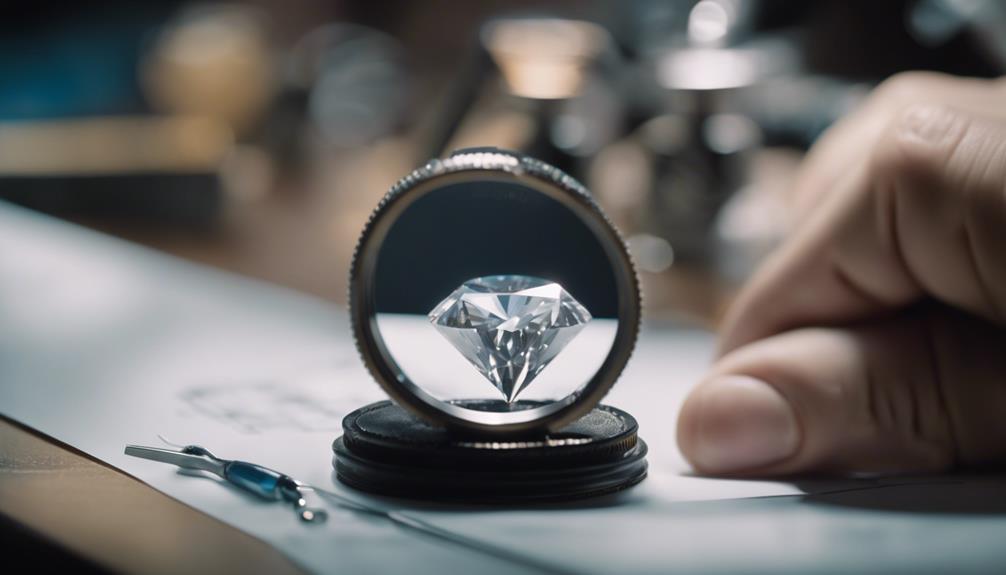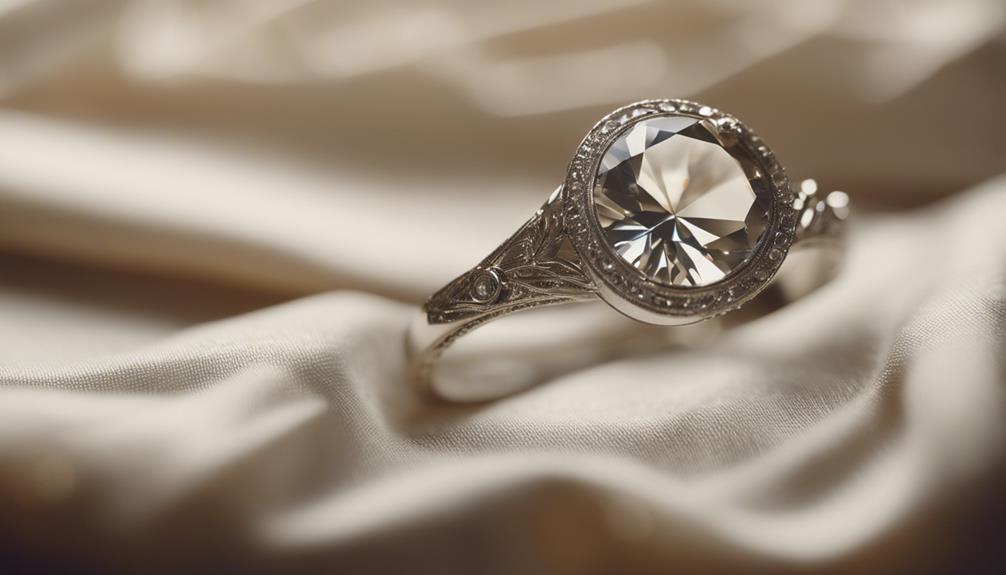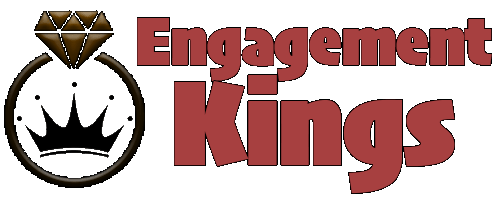GSI diamond certification is a service used by large U.S. retail chains like Jared and Zales to grade and appraise gemstones. However, its grading standards aren’t as strict as those of more reputable institutions like GIA, leading to potential inconsistencies in diamond evaluations. Retailers might use GSI certification to inflate valuations, impacting your diamond’s true worth and resale value. It’s crucial to be aware of these pitfalls before making a purchase. Prioritizing certifications from globally recognized authorities like GIA guarantees a fair assessment. Understanding these aspects can greatly influence your buying decisions and confidence. Keep on to discover key details and smart strategies.
GSI Certification Overview

GSI Certification is relatively new in the gemological world, primarily serving large U.S. retail chains like Jared and Zales. Founded in the 21st century, GSI aims to provide gemstone grading and appraisal services globally. Unlike established labs with decades of history, GSI’s main clientele consists of large retailers looking to maximize profits.
Unfortunately, GSI’s grading standards are looser compared to other reputable institutions like the Gemological Institute of America (GIA). Because of this, you might find their evaluations inconsistent, leading to inaccurate assessments of a diamond’s value. This discrepancy can make it difficult to trust the quality and worth of diamonds graded by GSI.
Retailers often use GSI certification to their advantage, selling diamonds with inflated valuations. It’s essential for you to recognize the potential pitfalls of relying solely on GSI certificates when making a purchase. By being aware of these issues, you can make more informed decisions and avoid overpaying for a diamond of questionable quality. Ensuring you seek out more reliable certifications will help you get the best value for your investment.
Diamond Grading Report
When you evaluate a diamond grading report, you’ll find it details the gemstone’s structure and quality, serving as a crucial reference for potential buyers. This report breaks down the 4 Cs: Cut, Color, Clarity, and Carat. Understanding these elements helps you make an informed decision about the diamond’s value.
The Cut evaluates the diamond’s proportions, angles, and symmetry, with grades ranging from Ideal to Poor. A superior cut enhances the diamond’s brilliance, making it the most important factor in determining overall value.
Color is graded from D (colorless) to Z (with a noticeable tint). Subtle differences in color can greatly impact price, even though adjacent grades are tough to distinguish.
Clarity assesses the diamond for inclusions and blemishes, affecting its overall appearance. Eye-clean diamonds, which have no inclusions visible to the naked eye, are highly sought after.
Carat measures the diamond’s weight, with one carat equivalent to 200 milligrams. Larger diamonds are rarer and consequently more valuable.
Financial Implications

Buying a diamond with a GSI certification might save you money upfront, but the inconsistent grading can lead to a lower resale value and questionable quality assurance. When you purchase a GSI-graded diamond, you’re likely paying less compared to a similar diamond certified by GIA. However, this initial saving comes with risks. GSI’s looser grading standards mean the diamond mightn’t be as high quality as it appears, affecting its long-term value.
You might think you’re getting a great deal, but the resale market views GSI certifications with skepticism. Buyers and jewelers often discount GSI-graded diamonds because they question the accuracy of the grading. This uncertainty can make it harder to sell your diamond later, and you may end up receiving less than you expected.
Moreover, GSI’s close ties with large retail chains suggest a conflict of interest. These retailers aim to maximize profits, sometimes at your expense. By relying on a more reputable certification like GIA, you guarantee a fair assessment of your diamond’s quality and value. This assures informed purchasing decisions and better financial outcomes in the long run.
Purchase Guidance
Maneuvering the diamond market can be challenging, but understanding key factors and seeking expert advice will help you make an informed purchase.
Start by familiarizing yourself with the 4 Cs: Cut, Color, Clarity, and Carat. Prioritize cut quality, as it greatly impacts a diamond’s brilliance and overall value. Remember, a well-cut diamond can appear more stunning than a larger, poorly cut one.
It’s essential to compare prices and certifications from different sellers. While GSI-certified diamonds might seem appealing due to their lower prices, be cautious. GSI’s grading leniency often results in diamonds that aren’t as high-quality as their grades suggest. Instead, aim for diamonds with GIA certifications, which are considered the gold standard for grading accuracy and consistency.
Don’t hesitate to seek guidance from industry veterans or professional jewelers. Their insights can help you avoid common pitfalls and guarantee you’re getting the best value for your money.
Also, keep an eye on market trends and shape preferences, as these can influence prices. By doing your homework and consulting experts, you’ll navigate the diamond market with confidence and make a purchase you’ll cherish for years to come.
Engagement Ring Insights

Choosing the perfect engagement ring can feel overwhelming, but understanding the essentials can make the process smoother and more enjoyable. Start by focusing on the 4 Cs—Cut, Color, Clarity, and Carat—since they greatly affect a diamond’s appearance and value. The cut is especially important, as it influences the diamond’s brilliance. Aim for an excellent or ideal cut to guarantee maximum sparkle.
Next, consider the ring’s setting. The setting not only holds the diamond in place but also enhances its beauty. Popular options include solitaire, halo, and three-stone settings. Choose one that complements your partner’s style and the diamond itself.
Certification is another key aspect. Avoid diamonds with GSI certificates due to inconsistent grading and potential overvaluation. Instead, opt for GIA-certified diamonds for reliable quality and fair value.
Don’t forget to set a budget. While it’s tempting to splurge, knowing your financial limits helps narrow down choices and reduces stress.
Finally, involve your partner in the process if possible. Their input can guarantee the ring meets their expectations and holds sentimental value.
Conclusion
In conclusion, understanding GSI’s diamond certification can help you make smarter decisions.
Be cautious of their looser grading standards and potential inconsistencies.
By thoroughly examining GSI’s grading reports, you can avoid overpaying and guarantee your diamond holds its value.
Stay informed and confident in your purchase, whether it’s for an engagement ring or another special piece.
Remember, knowledge is key to traversing the diamond market successfully.



